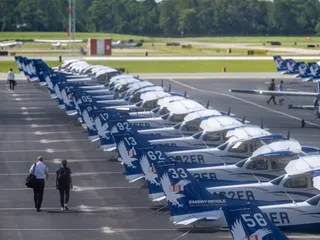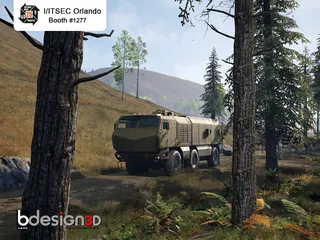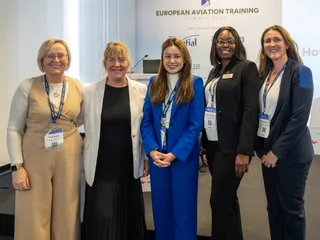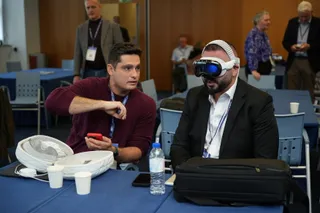Who Trains the Trainers?
Contact Our Team
For more information about how Halldale can add value to your marketing and promotional campaigns or to discuss event exhibitor and sponsorship opportunities, contact our team to find out more
The Americas -
holly.foster@halldale.com
Rest of World -
jeremy@halldale.com

Much has been written about becoming a pilot, but who trains the trainers?
Next to parents, many believe teachers are the most important individuals in the development of young minds. The same principal can be aptly applied to instructors/trainers, who guide prospective pilots though the labyrinth of obtaining various licenses and ratings. Those qualifications for pilots range from Private Pilot (PPL), Instrument Rating (IR), Multi-Engine Rating (MER) to Certified Flight Instructor (CFI), Commercial Pilot License (CPL) and Air Transport Pilot (ATP), the prerequisite and pinnacle license for most professional pilots.
Some in academia will insist on the disparaging, effete distinction: “Teachers teach and instructors instruct.” At days end, to this observer, they’re all teachers, who are tasked with an important job.
This is the first in a series of articles about the people who teach/train/instruct the pilots and aircraft maintenance technicians (AMTs) or engineers, as they’re called in Australia and elsewhere, of tomorrow.
An ERAU Perspective
“We’re careful about selection of instructors. It’s very focused,” Professor Kenneth P. Byrnes, Ph.D., Full Professor of Aeronautical Sciences at Embry-Riddle Aeronautical University’s (ERAU) Daytona Beach campus and Chairman of the Flight Training Department, said. “My favorite topic is explaining to [these instructor candidates] what is our expectation and mission. We talk a lot of our safety culture, professionalism and that they are role models” to the pilots of tomorrow, regardless of whether these students become recreational or professional pilots.
Potential instructor candidates at ERAU go through a four-part interview process. Which includes an initial flight interview, simulation exercises, written exam and one-on-one interview with ERAU leadership about the candidate’s technical and teaching abilities as well as the individual’s professionalism.
“Once through the interview the instructor enters initial standardization,” Byrnes said.
This includes eight simulator activities and an equal number of flights, which is part of the new-hire training process, with an instructors’ instructor, typically a veteran pilot educator from the flight standards department.
At the end of the interview process, there is an acceptance flight for the new instructor conducted by chief flight instructor or a designated senior pilot instructor.
After hire, newly-minted ERAU instructors are allowed to teach those on the private or instrumented-rated track only. As the instructors get more experience, ERAU requires upgrade training programs for to teach students for a higher rating and license.
“Every time, we give them a new privilege, they go through training again,” said Byrnes, who also is Assistant Dean of ERAU’s College of Aviation. “If they’re going to teach students going for the commercial license, the instructors go back to flight standards department” for additional instruction themselves.
He added: “Instructor annual recurrent training is AQP (Advanced Qualification Program) like.” By definition, AQP allows for more flexibility and customization in pilot training, with an emphasis on practical skills, safety and ongoing improvement.
Instructor pilots teaching candidates vying for multi-engine and CFI licenses go through this same process.
ERAU’s flight department also provides ad-hoc [as needed] training when trends are identified from their Flight Operations Quality Assurance (FOQA) data. For example, a result of isolated engine failures in ERAU’s Diamond Aircraft Industries DA42NG trainers, the flight department provided ad hoc recurrent training in the simulator on emergency procedures to ensure instructor proficiency.
The flight department also has Flight Instructor Quality Assurance (FIQA) program in which managers and senior instructors [called mentors] observe instructors’ teaching methods and provide feedback for improvement.
“Watching our graduates succeed, whether in the airlines, corporate flight departments, or the military, reinforces the impact and purpose of what we do every day,” Byrnes said.
Personal Journey
Byrnes’ early-on career plans were typical of most ERAU students on the professional pilot track. The dream was to one-day fly for major airlines.
After earning their flight certificates and ratings, most students gain experience as certificated flight instructors (CFIs) to build the flight time required for the Restricted Airline Transport Pilot (R-ATP) certificate.
Ninety-seven percent of the students are on a professional pilot track while around 3 percent become career instructors.
Byrnes took a different path eventually.
“I never left Riddle,” he recalled. “I was originally forced to stay due to market conditions [brought on by 9/11], but ultimately chose to remain in academia because
preparing future pilots and shaping aviation education is deeply fulfilling.”
Byrnes got his degree and became a full-time flight instructor for a few years. He later obtained his MBA and took on a leadership role at the university. He also got involved in the mentorship programs, as well as dealing with subject of organization culture and logistics.
“This period is essential for skill development and professional growth,” Byrnes said. “Teaching others to fly represents the highest level of learning, the correlation of knowledge, where understanding and application merge. It solidifies technical proficiency, sharpens judgment, and greatly enhances aeronautical decision-making (ADM).”
In his current role as Chairman of ERAU’s flight department, Byrnes is responsible for leading over 1,700 flight students, 240 CFIs, 30 certified Aircraft Maintenance Technicians (AMTs), aka A&P mechanics and 40 additional support staff members. Byrnes also is a flight instructor with an Airline Transport Pilot (ATP) rating and is a ground instructor.
Simulation as Instructional Tool
The interview pivoted to the teaching methods and training aids employed by ERAU, including Virtual Reality. For prospective CFIs, Byrnes created a teaching laboratory built around a Flight Training Device (FTD) donated by Frasca for classroom research. Outfitted with cameras and audio, the FTD allows entire classes, up to 25 students, to observe real-time teaching scenarios in a simulated flight environment.
“CFI ground school is all about role playing and the application of the fundamentals of instruction, not just theory,” Byrnes explained. “Each prospective CFI prepares a lesson plan, then teaches a maneuver (such as steep turns) while another student, who is assigned to role play a specific personality, learning style, [and] defense mechanism, acts as a learner. The rest of the class observes, identifies [the] learners’ attributes and critiques the instructor’s effectiveness.”
Byrnes said he adapted this concept from education models at the University of Central Florida, which use avatars to train teachers in a classroom environment.
The laboratory also serves as a grade-calibration and professional-development tool for ERAU instructors, promoting consistent evaluation standards and reflective teaching.
The initiative complements Embry-Riddle’s broader use of simulation and VR in flight education. The university also uses VR to provide training to new instructors on teaching tips and tricks to improve instructor teaching ability.
“We recorded our best instructors performing each maneuver using 360-degree visuals with voice-over instruction,” Byrnes said. “Now, every new instructor can virtually
experience how to teach landings, slow flight, or stalls. It’s a powerful way to pass along proven techniques to new instructors and elevate instructional quality at very little cost.”
Maintaining high standards for instructors at all levels of pilot proficiency is of paramount importance. “We can have the best airplanes, resources, curriculum and brand in the world,” Byrnes said. “But it doesn’t mean a damn thing if the instructor isn’t good. It’s all about the delivery. We have to focus on instructor quality.”
He paused and added another reason why he remains in academia: “Sometimes I enjoy getting stuck at Atlanta [Atlanta Hartsfield-Jackson Atlanta International Airport]. Occasionally, a former student will walk by and remember me. I enjoy that very much.”
Discover ERAU’s new programs, research, and training initiatives by reading New ERAU Programs Available.


